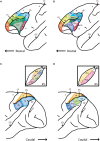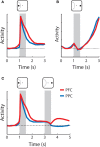Unique and shared roles of the posterior parietal and dorsolateral prefrontal cortex in cognitive functions
- PMID: 22563310
- PMCID: PMC3342558
- DOI: 10.3389/fnint.2012.00017
Unique and shared roles of the posterior parietal and dorsolateral prefrontal cortex in cognitive functions
Abstract
The dorsolateral prefrontal cortex (PFC) and posterior parietal cortex (PPC) are two parts of a broader brain network involved in the control of cognitive functions such as working-memory, spatial attention, and decision-making. The two areas share many functional properties and exhibit similar patterns of activation during the execution of mental operations. However, neurophysiological experiments in non-human primates have also documented subtle differences, revealing functional specialization within the fronto-parietal network. These differences include the ability of the PFC to influence memory performance, attention allocation, and motor responses to a greater extent, and to resist interference by distracting stimuli. In recent years, distinct cellular and anatomical differences have been identified, offering insights into how functional specialization is achieved. This article reviews the common functions and functional differences between the PFC and PPC, and their underlying mechanisms.
Keywords: attention; intraparietal sulcus; monkey; neuron; neurophysiology; persistent activity; principal sulcus.
Figures



Similar articles
-
Working Memory and Decision-Making in a Frontoparietal Circuit Model.J Neurosci. 2017 Dec 13;37(50):12167-12186. doi: 10.1523/JNEUROSCI.0343-17.2017. Epub 2017 Nov 7. J Neurosci. 2017. PMID: 29114071 Free PMC article.
-
Lower neuronal variability in the monkey dorsolateral prefrontal than posterior parietal cortex.J Neurophysiol. 2015 Oct;114(4):2194-203. doi: 10.1152/jn.00454.2015. Epub 2015 Aug 12. J Neurophysiol. 2015. PMID: 26269556 Free PMC article.
-
Comparison of neural activity related to working memory in primate dorsolateral prefrontal and posterior parietal cortex.Front Syst Neurosci. 2010 May 14;4:12. doi: 10.3389/fnsys.2010.00012. eCollection 2010. Front Syst Neurosci. 2010. PMID: 20514341 Free PMC article.
-
Common fronto-parietal activity in attention, memory, and consciousness: shared demands on integration?Conscious Cogn. 2005 Jun;14(2):390-425. doi: 10.1016/j.concog.2004.10.003. Epub 2004 Dec 8. Conscious Cogn. 2005. PMID: 15950889 Review.
-
Role of Prefrontal Persistent Activity in Working Memory.Front Syst Neurosci. 2016 Jan 5;9:181. doi: 10.3389/fnsys.2015.00181. eCollection 2015. Front Syst Neurosci. 2016. PMID: 26778980 Free PMC article. Review.
Cited by
-
Functional differentiation of the dorsal striatum: a coordinate-based neuroimaging meta-analysis.Quant Imaging Med Surg. 2023 Jan 1;13(1):471-488. doi: 10.21037/qims-22-133. Epub 2022 Sep 14. Quant Imaging Med Surg. 2023. PMID: 36620169 Free PMC article.
-
Influence of monkey dorsolateral prefrontal and posterior parietal activity on behavioral choice during attention tasks.Eur J Neurosci. 2014 Sep;40(6):2910-21. doi: 10.1111/ejn.12662. Epub 2014 Jun 25. Eur J Neurosci. 2014. PMID: 24964224 Free PMC article.
-
Working Memory and Decision-Making in a Frontoparietal Circuit Model.J Neurosci. 2017 Dec 13;37(50):12167-12186. doi: 10.1523/JNEUROSCI.0343-17.2017. Epub 2017 Nov 7. J Neurosci. 2017. PMID: 29114071 Free PMC article.
-
Frontal and Parietal Activities Associated With Different Inhibitory Processes in a Stroop-Matching/Stop-Signal Task: A Channel-Wise fNIRS Study.Psychophysiology. 2025 Jul;62(7):e70098. doi: 10.1111/psyp.70098. Psychophysiology. 2025. PMID: 40621683 Free PMC article.
-
Neural Research on Depth Perception and Stereoscopic Visual Fatigue in Virtual Reality.Brain Sci. 2022 Sep 11;12(9):1231. doi: 10.3390/brainsci12091231. Brain Sci. 2022. PMID: 36138967 Free PMC article.
References
Grants and funding
LinkOut - more resources
Full Text Sources
Miscellaneous

